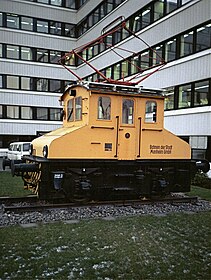LMH 1
| LMH 1 | |
|---|---|
|
LMH 1 as a memorial in Berlin (Nonnendammallee, 1988)
|
|
| Numbering: |
LMH 1 BSM 1 |
| Number: | 1 |
| Manufacturer: |
AEG (manufacture no.685) |
| Year of construction (s): | 1908 |
| Retirement: | 1980 |
| Axis formula : | Bo |
| Gauge : | 1435 mm ( standard gauge ) |
| Length over buffers: | 6,240 mm |
| Length: | 4,940 mm |
| Height: | 3,400 mm (to the roof edge) |
| Width: | 2,500 mm |
| Total wheelbase: | 2,500 mm |
| Service mass: | 19.6 t |
| Friction mass: | 19.6 t |
| Wheel set mass : | 9.8 t |
| Hourly output : | 2 × 47 kW (2 × 64 PS) |
| Power transmission: | electric |
| Power system : | 800 V = |
| Power transmission: | Overhead line |
| Number of traction motors: | 2 |
| Brake: |
Indirect brake type Knorr, hand brake |
The LMH 1 was a two-axle industrial locomotive of the AEG , which was manufactured in 1908 and used in shunting and factory traffic on the Kleinbahn Langenfeld-Monheim-Hitdorf (LMH) - since 1963 railways of the city of Monheim (BSM).
The electric locomotive was in use by the company until the end of electrical operation in 1980. The locomotive was then erected as a memorial at various AEG locations and was scrapped in 1999.
History and commitment
The locomotive was the first on the Kleinbahn, passenger traffic was carried out with railcars. In 1921 a second locomotive of the same size and power was delivered, which was given the number 2 .
Both locomotives were no longer able to cope with the increased volume of goods at the end of the 1920s. In order to increase the friction weight, a ballast of almost one ton was added to it in 1909 . The permissible train weight of the locomotives was 175 t. After the LMH 15 was acquired in 1928, the locomotives were only used in subordinate services (construction trains, shunting work). Nevertheless, the locomotive 1 remained until the end of electrical operation.
After the end of electrical operation, the locomotive was sold to AEG , which erected it as a memorial at various locations in Berlin . The locomotive was intended as an exhibit for a future transport museum in Berlin. In 1999 the locomotive was no longer used, and was scrapped in the same year.
technology
The locomotive had a central driver's cab and two stems. It was designed using direct current technology, which required a resistance control to control the locomotive. The two traction motors of 47 kW each were designed as deadbearing traction motors .
When the locomotive started operating, it was fitted with a handbrake; the indirect brake was not fitted until 1930. At the beginning, it had a trumpet clutch in addition to the pulling and bumpers .
literature
- Stefan Kunig, Gunter Mackinger: The railways of the city of Monheim . Kenning Verlag, Nordhorn 2008, ISBN 978-3-933613-94-3 , pp. 51 .
Web links
Individual evidence
- ↑ a b Articles about the railways of the city of Monheim with mention of the 1 and 2
- ↑ a b c d Stefan Kunig, Gunter Mackinger: The railways of the city of Monheim . Kenning Verlag, Nordhorn 2008, ISBN 978-3-933613-94-3 , pp. 51 .
- ^ Stefan Kunig, Gunter Mackinger: The railways of the city of Monheim . Kenning Verlag, Nordhorn 2008, ISBN 978-3-933613-94-3 , pp. 12 .
